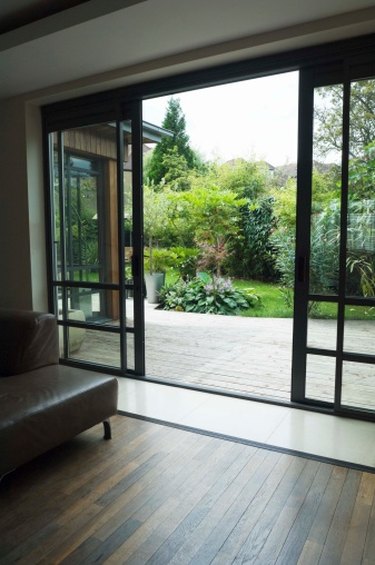
Minimalist design is characterized by simple architecture, furnishings and accessories. Minimalism was an artistic movement that became popular in the late 1960s and was influenced by the straight, clean lines and simple spaces found in traditional Japanese design. Everything in minimalist design is stripped down to only the most essential elements, ridding everything that creates clutter or takes up too much space.
Architecture
Video of the Day
The architecture of a minimalist home or building is simple and basic. Rather than covering wood beams, they are left untouched or simply stained an attractive dark wood color. Instead of closing in a small space underneath the stairs, it is open. Roofs are more flat than pitched and the use of walls is limited, creating an open living space. Floor, wall and countertop finishes are simple and sleek and left in or close to their natural state, whether it is stone, metal or wood.
Video of the Day
Walls
Walls are usually white in minimalist interior design. The idea is to create a space that looks clean, which is why white pairs so well with the style. Pale terra-cottas, neutrals or colors reflecting the surrounding nature may also be used on the walls, as long as they are not distracting or make the space feel enclosed. Storage may be hidden in the walls, such as a large closet that is covered by reflective mirror doors made in a way to accent the design.
Windows
Windows are a major design element in minimalist design. Large windows work best because they allow the space to virtually become one with its natural surroundings. Fussy blinds or curtains are usually not used. If you prefer to use blinds or curtains, choose natural wood or bamboo shades and sheer curtains. Keep windows clean to prevent buildup that may block an outdoor view.
Floors
Use flooring that is simple and natural, such as real wood or stone tiles. Shiny floors create a clean look, while muted floors reflect a natural state. Either style may be used in minimalist design, depending on the look you are going for. Some designs are modern and futuristic, making use of shiny flooring that looks as though it is one piece. Others are "one" with nature, using natural, muted wood or stone floors, reflecting the materials seen outdoors.
Furniture
Choose furnishings that are simple, geometric shapes and made of natural materials, such as a square wood table. Furniture that is low to the ground creates a modern look and also reflects the Japanese influences in the style. Use furnishings that do not take up too much space and provide only what is necessary, such as a resting area made up of simple chairs and large floor pillows or a bed that sits low to the ground with a simple wooden surround. Large furnishings that are bulky are unnecessary.
Accessories
Accessories should provide visual interest in the space. Bolder colors and designs can be used in the accessories because they are small and not too distracting. Make use of materials such as chrome and steel to create a look of cleanliness and wood or clay to bring in a touch of nature. Only the minimal amount of accessories should be used to avoid clutter.